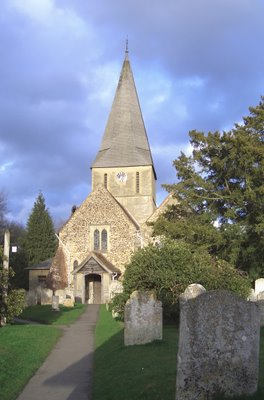
They lived the lives of urban hermits, but often played surprisingly public roles, communicating with members of the community through the small windows used for passing food into the cell. Anchorites were often literate, and even taught others to read. They also were given some judicial authority within their communities, and were therefore called upon to mediate conflicts. Apparently they also preached, although they were strictly forbidden from performing any of these activities.
In order to visit an anchorage, last weekend I went to the town of Shere, about an hour south of London. Shere is a picturesque village in the chalk hills, with a small church dedicated to St. James. The church had an anchorage built into the north wall in the fourteenth century. The anchorage is no longer there, but the stones indicate where the five-square-foot cell was.

 The place, as well as the concept of walling oneself up in the side of a church, has caught the attention of Paul Moorcraft, author of Anchoress of Shere (2002). This is a tense thriller, set in late twentieth-century Shere, about a group of scholars who comes to the village to study anchoresses and what would drive them to elect to be walled up. One of these scholars is Father Michael Duval, who becomes obsessed with his research in a way that goes beyond the normal obsessions that we often have with our subjects. In the process of writing the biography of Christine Carpenter, Duval kidnaps a series of young women in order to reconstruct his image of the fourteenth-century anchorite for whom the Shere cell was built.
The place, as well as the concept of walling oneself up in the side of a church, has caught the attention of Paul Moorcraft, author of Anchoress of Shere (2002). This is a tense thriller, set in late twentieth-century Shere, about a group of scholars who comes to the village to study anchoresses and what would drive them to elect to be walled up. One of these scholars is Father Michael Duval, who becomes obsessed with his research in a way that goes beyond the normal obsessions that we often have with our subjects. In the process of writing the biography of Christine Carpenter, Duval kidnaps a series of young women in order to reconstruct his image of the fourteenth-century anchorite for whom the Shere cell was built. 
Because Shere is built in a valley of chalk, which is unsuitable as a building material, the stones for the church had to be brought from other areas. In this photo, you can see that someone incorporated a wheelbarrow-full of black pebbles about mid-way up the wall.
*Anneke B. Mulder-Bakker, Lives of the Anchoresses: The Rise of the Urban Recluse in Medieval Europe, tr. Myra Heerspink Scholz, The Middle Ages Series (Philadelphia, PA: University of Pennsylvania Press, 2005).